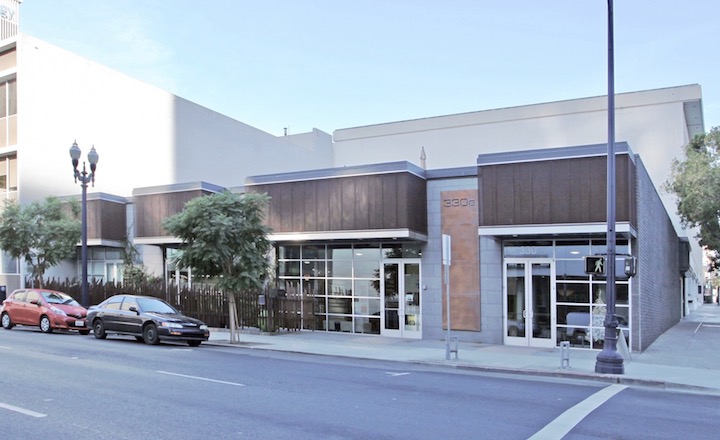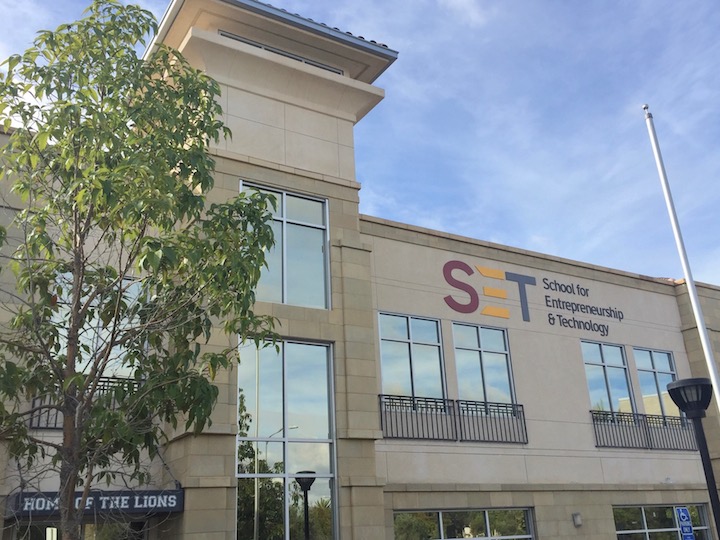Daily Business Report-Jan. 13, 2017
The School for Entrepreneurs & Technology in Serra Mesa.
New Charter High School Aims to
Shape Entrepreneurs of the Future
The School for Entrepreneurship & Technology (SET), a free charter high school with an enrepreneurial and technology-driven curriculum, has opened its enrollment for the 2017-2018 school year.

The freshman class of 2021 comprises 80 students, and enrollment is open to students in San Diego County. Enrollment deadline is March 1. Tuition is free at the school, which is in the San Diego Unified School District. It is located in Serra Mesa (3540 Aero Court). The four-year accredited charter school serves grades nine through 12.
According to school officials, the SET concept was established to reflect the vital role entrepreneurism and technology have played and continue to play in today’s global economies. “A recent study showed 72 percent of high school students want to start their own business some day. And in fact, of the 27 million working-age Americans, nearly 14 percent are starting or currently running businesses, according to the GEM 2015 report.”
“Our world is built on the spirit of entrepreneurship; it makes sense to provide this foundation to young adults, especially as one in nearly seven Americans will be an entrepreneur at one time in their life,” said Neil McCurdy, chief educational officer. “We have designed an innovative, entrepreneurial mindset-driven curriculum where students are given valuable tools to showcase their personal brand, which can be transferred to all aspects of their personal and professional lives in the future.”
Officials said students in the school will be able to meet the “A-G” subject requirements for University of California and California State University schools. A-G refers to the subjects and number of years of each subject.
“SET’s diverse academic student body never exceeds 320 students, assuring a highly personalized learning environment,” said McCurdy. “Families are encouraged to schedule a visit to the SET campus to learn more about the available programs and school culture.”
Enrollment is at www.SETHigh.org.
____________________________
Mayor: Dean Spanos Will Regret
Decision to Leave San Diego
Mayor Kevin Faulconer said Thursday the Chargers made a bad decision to leave San Diego and owner Dean Spanos will ultimately regret it.
“Dean Spanos made a bad decision and he will regret it. San Diego didn’t lose the Chargers. The Chargers just lost San Diego,” Faulconer said at a press conference.
The Chargers rejected every offer from the city, according to the mayor, including one made just weeks ago. “At the end of the day, the Chargers wanted a lot more taxpayer money than we could ever agree to,” Faulconer said.
Other area officials were harsher in their assessments, accusing the team’s owners of negotiating in bad faith.
City Councilman Scott Sherman said the ownership was a problem throughout the whole process, and they never gave a straight answer to anything.
“(Chargers stadium counsel) Mark Fabiani and Dean Spanos have tirelessly worked behind the scenes to subvert every single action of the City Council and this mayor have done to try and put something on the table to try and keep the Chargers here,” Sherman said.
San Diego State University President Elliot Hirshman, who helped craft a last-ditch offer to Spanos, said countless good-faith discussions were held on the stadium issue.
“Unfortunately, we didn’t have a good faith partner,” Hirshman said, referring to the Chargers.
SDSU stands to benefit from the team’s departure through redevelopment of the Qualcomm Stadium site, which college officials have eyed for years for expansion. The site could also hold a new stadium for the Aztecs football program, as well as a professional soccer team.
The decision climaxing the Chargers’ long-running search for a new playing facility came two months after the defeat of Measure C, which would have raised hotel room taxes to provide the public portion of the cost of building a downtown stadium. Because of the tax increase, the ballot measure required two-thirds approval to pass, but it failed to even get a simple majority.
San Diego City Councilman Chris Cate, who led the opposition to Measure C, said he didn’t find the announcement surprising.
“It became apparent in 2015 that the Chargers preferred Los Angeles, as they continued to show an unwillingness to negotiate a potential stadium deal here in San Diego, and with their recent action to execute a lease for a new headquarters and practice facility outside of the city,” Cate said. “I accept the Chargers decision and understand that they believed this action was the best financial decision for their business.”
He said he will turn his focus to “finding a long-term vision for the Mission Valley site” of Qualcomm Stadium that will be “in the best interest of San Diegans.”
On Twitter, Supervisor Ron Roberts, who led county efforts to find a new home for the team, said, “The Chargers will stand next to Donald Sterling in the Hall of Shame. It hurts, but we will move on. San Diego is a great community.”
Sterling is the former owner of the San Diego Clippers who moved that franchise to Los Angeles in the 1980s.
City News Service contributed to this article.
____________________________

New Oceanside Apartment Project
To Include 38 Affordable Rentals
The city of Oceanside will get 38 new affordable rental apartments in 2017 from a collaborative efforts of Integral Communities and Chelsea Investment Corp., one of the region’s largest developers of affordable housing.
Integral Communities, developer of the 35.5-acre Mission Lane community, formerly known as Villa Storia, donated the land and contributed money to Chelsea who secured the remaining financing needed to create the project.
Chelsea’s apartment community is the first inclusionary project in Oceanside under the city’s Inclusionary Housing Ordinance, which requires projects of three or more homes to reserve at least 10 percent of the units for low-to moderate-income families, or pay a fee. Integral Communities chose to donate the land and subsidize the development so the inclusionary units were built as part of the overall project.
A total of 379 apartments will be built at Mission Lane, located on formerly vacant property adjacent to the historic Mission San Luis Rey off Mission Avenue. Beazer Homes, a national homebuilder, is now building market rate for-sale housing on several planning areas within the development.
Chelsea’s Villa Storia affordable community will include 12 one-bedroom, 20 two-bedroom, and six three-bedroom units ranging from 550 to 1,000 square feet. Two three-story buildings designed in Spanish Colonial styling will be surrounded by open space, including walkways and benches. Amenities include a tot lot and children’s play area, community room, and generous onsite parking.
Families that earn 50 to 60 percent of the San Diego County Area Median Income (AMI) qualify to rent the units. Leasing activity will start this summer, with move-ins anticipated this fall.
____________________________

Downtown Office Building Sells for $6.25 Million
A 9,000-square-foot office building at 330 A St. in Downtown San Diego has been sold for $6.25 million.
The buyers were identified as IGC 330 A Street LLC, JTC 330 A Street LLC and JKC 330 A Street LLC. The seller was Waynlo Building Corp.
The building was built in 1962 and underwent a full renovation in 2010. It is located on the corner of A Street and 4th Avenue, blocks away from the Gaslamp Quarter and the B Street Corridor. During its renovation in 2010, the building was completely built-out with an open and collaborative work environment complete with exposed ceilings throughout, a street-level patio and a rooftop deck.
The transaction was arranged by the NAI San Diego | Office Property Group.
____________________________
Cal State San Marcos to Host Kinsey
African American Art and History Collection
California State University San Marcos is hosting a one-day event on Friday, Feb. 3 for educators and students to learn how The Kinsey African American Art and History Collection can bring new understanding to the issues of equity and access facing students.
The Kinsey Collection was amassed by Bernard and Shirley Kinsey and includes authentic artifacts, books, letters, manuscripts and photographs that document the African-American experience from 1595 to modern day.
Former Xerox CEO Bernard Kinsey will share pieces of his collection, introduce the “myth of absence” concept that has shaped views of African-Americans, and shed light on the unknown history of African-American leaders in U.S. history.
CSUSM’s College of Education, Health and Human Services (CEHHS) is sponsoring the event in conjunction with the San Diego County Office of Education.
“This event is an outstanding opportunity for students to learn about little-known contributions and achievements of African-Americans,” said Janet Powell, dean of CEHHS. “For educators, it’s also a chance to learn how to bring new understanding of equity and access issues to students.”
The program is from 10 a.m.-2 p.m. Tickets are $25 for students, $75 for others and includes lunch. The first 50 CSUSM students to register will receive free admission.
What: The Kinsey Collection, an exhibit amassed by Bernard and Shirley Kinsey containing authentic artifacts, documents, photographs and more that document the African-American experience from 1595 to modern day.
When: 10 a.m.-2 p.m., Feb. 3
Where: California State University San Marcos
Tickets: $75 per person, $25 for students (lunch included); free admission for first 50 CSUSM students to register
Information/registration: Visit the San Diego County Office of Education website




